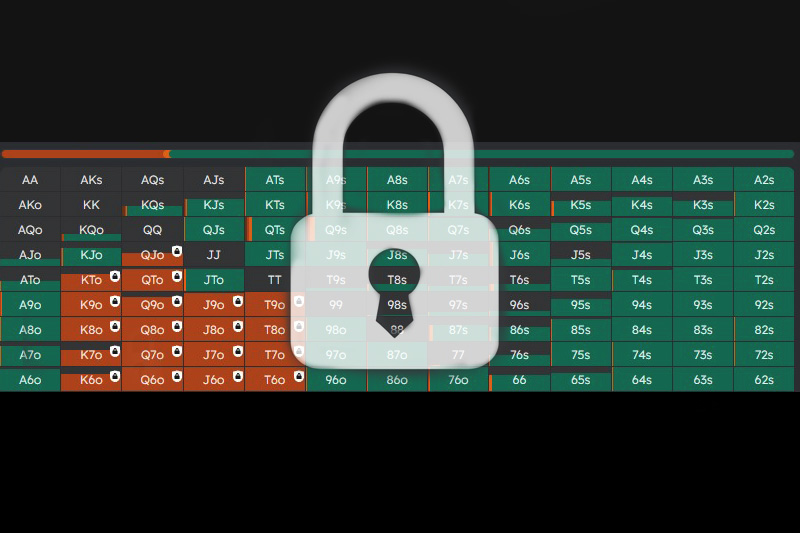Get ready for some exciting updates! Our developers team at Poker Academy has rolled out a brand new feature, the node locking. Node locking, also known as node lock, is a method where players adjust their strategy based on an opponent’s tendencies at decision points in a hand, allowing for strategic manipulation and improved win rates. Dive in to uncover what node locking is all about and how it can elevate your simulation experience!
In our previous update, we shared exciting news about the expansion of Poker Academy’s preflop module, introducing the first simulations that consider the occurrence of BBA. If you missed it, we encourage you to catch up.
Today, we’re thrilled to share another significant enhancement: the integration of a node locking feature into our ultra-fast postflop solver. But before we dive into its utilization, let’s take a moment to understand what this concept truly entails.
What is node locking?
In essence, node locking is the process of adjusting the strategy within a specific node to consider deviations from the optimal strategy in an opponent’s gameplay and their tendencies. It is a technique employed to develop strategies that can exploit these deviations.
The theoretical underpinnings of node locking
The strategies produced by the solver are derived from a contest between two players who are playing optimally. Each player is fully aware of their own strategy and that of their adversary.
Leveraging the computational prowess of contemporary computers, solvers determine strategies for both players that meet the conditions of Nash Equilibrium. This implies that neither player can independently alter their strategy to raise their Expected Value (EV). Any deviation from this optimal strategy makes the player susceptible to exploitation.
However, it’s important to remember that in real-life scenarios, no one plays optimally. Node locking gives us the chance to adjust the simulation outputs to account for the behaviors of opponents who deviate from the “optimum”. By fixing their strategy through node locking, we can influence different branches of the game tree, ensuring that errors on one part of the game tree do not compromise our overall strategy. This equips the solver with the necessary tools to devise the most efficient counter-strategy, one that maximizes our EV.
How node locking works in Poker Academy?
Firstly, let’s guide you to the location where you can adjust your strategy. In the upper right corner of your screen, there is a button labeled “Find Exploits”. Clicking on this will open up a menu, providing you with the ability to modify your strategic approach by understanding opponent plays and making necessary adjustments using node locking.
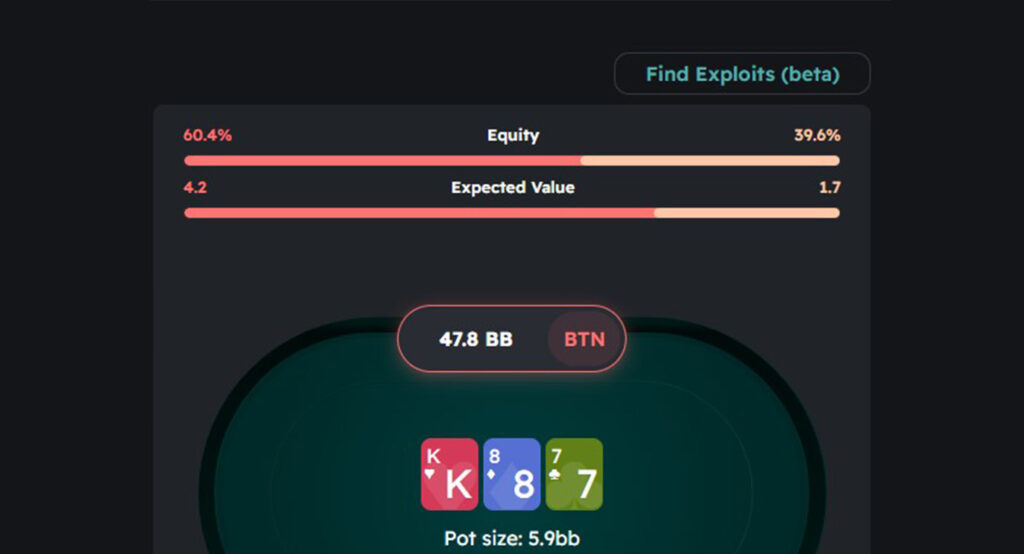
Prior to implementing any alterations to the strategy devised by the solver, it is crucial to examine the Expected Value (EV) of the overall range. This value should be noted as it serves as a benchmark against which the EV of the range post-modification will be compared. The overarching goal should always be to maximize the EV.
Node locking modes: Manual and GTO
There are two modes to choose from: “Manual” and “GTO”.
In the former, you have complete freedom to modify the strategy, i.e., you can change the type of action, bet sizes (within those predefined) and frequency (this is set with a slider).
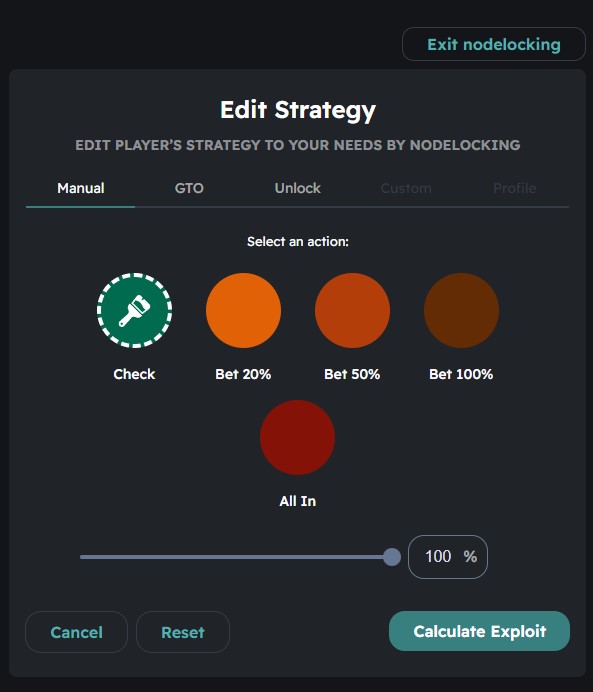
In the latter, you can block the frequency of the play according to the GTO solution. Understanding the GTO solution is crucial before making any adjustments in the GTO mode, as it provides the optimal strategy baseline.
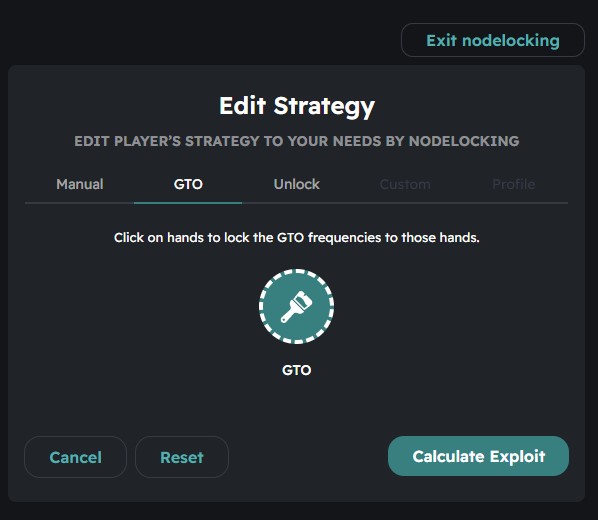
Each time you block a hand, a small padlock icon will manifest on the matrix. To remove this, navigate to the “Unlock” tab.
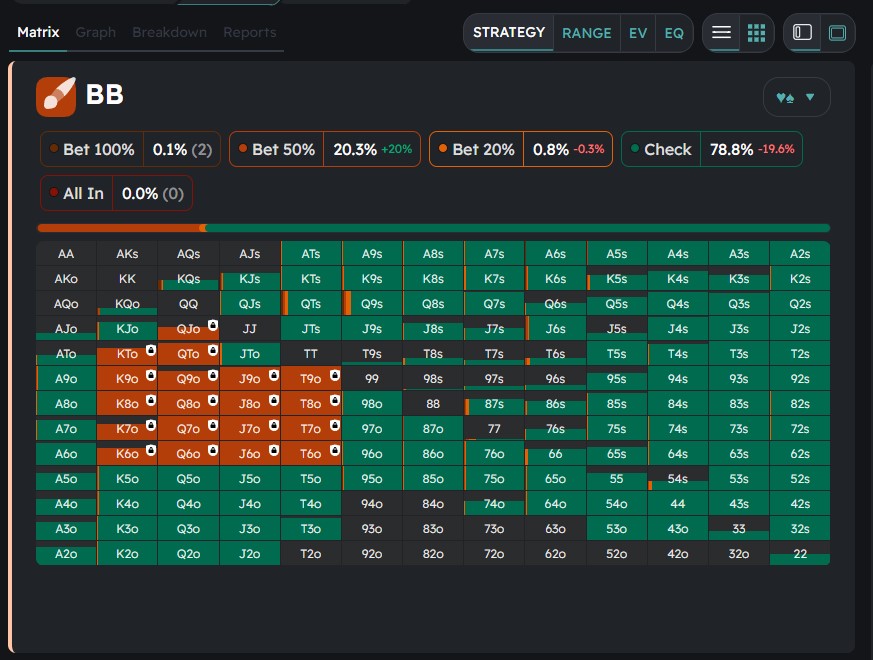
Once you are satisfied with the modifications you’ve implemented, proceed by clicking on the “Calculate Exploit” button. The solver will swiftly implement the changes and display the results. You’ll observe that post-modification, the padlocks are no longer present in the matrix.
Turning our attention to the most crucial aspect—an examination of how the Expected Value (EV) of our range has been influenced. It appears that our arbitrarily implemented changes have had a negative impact, as indicated by the decrease in the EV value (from 1.7 to 1.5). In light of this, it would be prudent to retract these modifications and either revert to the GTO benchmark or explore further alterations.

It’s important to acknowledge the changes we’ve implemented in our strategy have had a direct impact on our competitor as well. This is evident when considering the principle of a zero-sum game, where one entity’s loss or gain is balanced by the losses or gains of the other entities involved. A comparison of the Expected Values (EVs) post-modifications validates this theorem, as our decrease in EV was mirrored by an equal increase in our competitor’s EV.
| EV before | EV after | |
| Villain | 4,2 | 4,4 |
| Hero | 1,7 | 1,5 |
Conclusion
We appreciate your time and attention in reading this text through to its conclusion. If you have any thoughts or feedback regarding the introduction of node locking to the Poker Academy, we invite you to share them on our community Discord.
In the near future, we plan to further support your learning. It will be either by releasing a training video or hosting a webinar (still to be decided) that will provide practical guidance on how to leverage the new capabilities offered by the Poker Academy solver.
See you next time.
